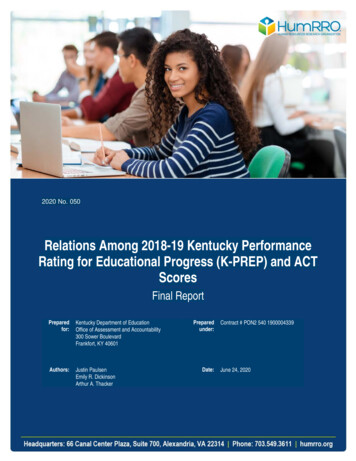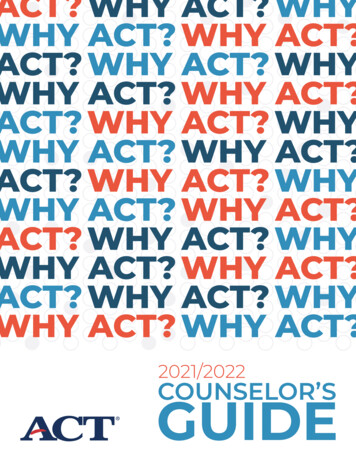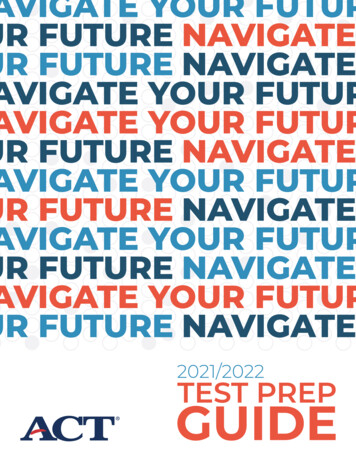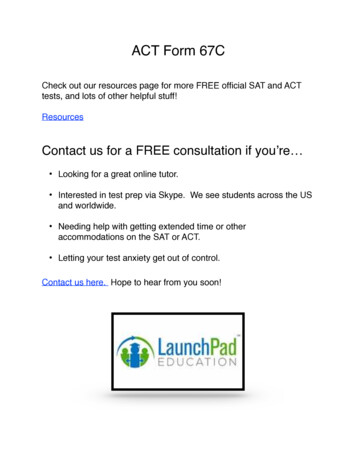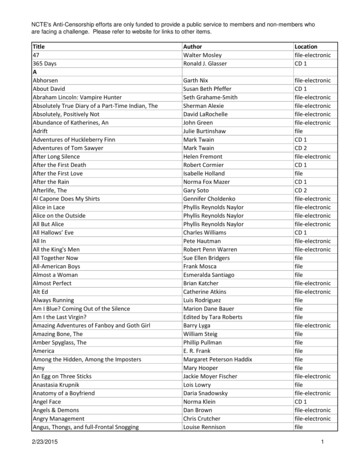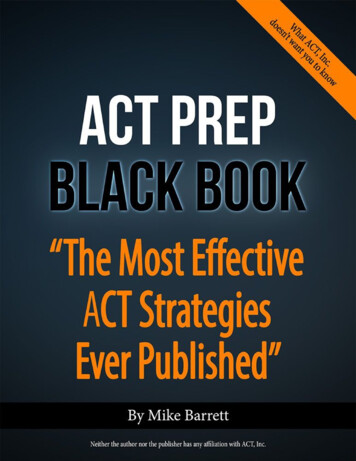
Transcription
I attribute my success to this—I never gave or took any excuse.- Florence Nightingale
Copyright 2014 by Mike Barrett.All rights reserved.
Neither the author nor the publisher of this book has any affiliation with ACT, Inc., nor with the ACTtest, nor with any other person mentioned in this book, nor with any test preparation companymentioned in this book apart from Testing Is Easy LLC. All trademarks are the property of theirrespective owners. Every reasonable effort has been made to ensure that the information in this bookis correct, but any use of this book or reliance on the ideas contained herein is strictly at your ownrisk.
The ACT Prep Black Book“The Most Effective ACT Strategies Ever Published”By Mike Barrett
DedicationThis book is dedicated to my friends and family—past, present, and future—and to my many clientsand readers the world over, some of whom have become like friends and family themselves. Yoursteadfast support has been a blessing, and I am more grateful than I can say.
Free Video DemonstrationsIf you’d like to see videos of sample ACT solutions like the ones in this book, please visitwww.ACTprepVideos.com. A selection of free videos is available there for readers of this book.
TABLE OF CONTENTSDEDICATIONFREE VIDEO DEMONSTRATIONSNOT HARD—JUST UNUSUALGETTING THE MOST OUT OF THE ACT PREP BLACK BOOKA NOTE TO CONCERNED PARENTSFREQUENTLY ASKED QUESTIONS“HOW WELL CAN I DO ON THE ACT?”HOW TO TRAIN FOR THE ACT—MASTERING THE IDEAS IN THIS BOOKUNDERSTAND YOUR MISTAKESTHE “NATURAL TEST-TAKER”WHAT YOU MUST UNDERSTAND ABOUT THE ACTTHE TRUTH ABOUT THE ACTTHE ACT’S BIGGEST WEAKNESSUSING THE REAL ACT PREP GUIDE, 3RD EDITION (THE “RED BOOK”)CARELESSNESS WILL COST YOUHITTING A TARGET SCORETHE GENERAL GAME PLAN FOR ATTACKING A SECTION OF THE ACT ON TEST DAYTIMING ISSUESREADING PASSAGES ON THE ACTACT TRAININGACT READINGHow To Read Passages On The ACT Reading SectionThe General Process For Answering ACT Reading QuestionsWalkthroughs: The ACT Reading Process In Action Against Real QuestionsACT Reading Quick SummaryACT MATHACT Math ToolboxUnwritten Test Design Rules Of ACT MathTesting ValuesACT Math Answer-Choice PatternsThe General Process For Answering ACT Math QuestionsACT Math Closing ThoughtsWalkthroughs: The ACT Math Process In Action Against Real QuestionsACT Math Quick SummaryACT SCIENCEUnwritten Test Design Rules Of ACT ScienceHow To Read Passages On The ACT Science SectionUsing Simple Trends To Make PredictionsACT Science Question TypesACT Science Answer-Choice PatternsThe General Process For Answering (Most) ACT Science QuestionsWalkthroughs: The ACT Science Process In Action Against Real QuestionsACT Science Quick SummaryACT ENGLISHCommas In The ACT English SectionACT English Question TypesHow To Read Passages On The ACT English SectionThe General Process For Answering ACT English QuestionsACT English Answer-Choice Patterns And IssuesWalkthroughs: The ACT English Process In Action Against Real QuestionsACT English Quick SummaryACT WRITING TEST (THE ACT ESSAY)Unwritten Test Design Rules Of The ACT Essay (ACT Writing Test)Recommended Step-By-Step Approach To The ACT Essay
Example ACT EssayAnalysis Of Sample Essays In The Real ACT Prep Guide, 3 rd EditionACT Writing Test (The ACT Essay) Quick SummaryYOU HAVE TO PRACTICEWHEN THINGS GO WRONG4 ACT MYTHSSHOOTING FOR A 36IF AMERICAN ENGLISH ISN’T YOUR FIRST LANGUAGE . . .PARTING ADVICETHANKS FOR READING!APPENDIX: WRITING TOOLBOX
Not Hard—Just Unusual“Every great and deep difficulty bears in itself its own solution. It forces us to changeour thinking in order to find it.”- Niels BohrMillions of students worry over the ACT every year. They spend countless hours (and dollars) tryingto cram scientific theories and obscure trig formulas into their heads so they can get the best possiblescore—and most of them just end up frustrated and unhappy with their results, despite all their work.If you’re reading this book, it’s probably because you’re also unhappy with your performance so faron the ACT. (If you were happy with your score, you wouldn’t need to keep preparing, right?)Because so many people have such a tough time with the ACT (and with other standardized tests likeit), the test has developed a reputation for being a difficult obstacle to overcome. A lot of people willtell you that the only way to “prepare” for the ACT is to read novels, study advanced math, take APscience classes, watch the Discovery Channel between practice essay sections, and do all kinds ofother pointlessly rigorous things.But those people are wrong. The ACT isn’t hard because it’s advanced. It’s hard because it tests thebasics—but in very strange ways. It’s designed according to rules that are actually pretty simple,even though they’re also pretty different from the rules that govern tests in high school and college.That’s a very important idea, so make sure you never forget it: the ACT is only challenging becauseit’s a weird test of basic skills, not because it’s an advanced test that rewards you for being a genius.This book will teach you a simple and effective approach to the test, an approach that exploits theweaknesses created by the standardized nature of the ACT. You’ll learn to take the knowledge youalready have and apply it to the ACT in a way that the test will actually reward, so you can achieveyour highest possible score.The approach I’ll show you in this book is one I’ve taught to many, many students who used it to getmuch better scores on the ACT than they originally thought possible. If you pay careful attention to theideas and examples in this book, you can use this information to increase your score, as well—butthat won’t happen unless you actually make an effort to learn and practice these strategies.Don’t expect to read this whole book through once and then just automatically be able to find thecorrect answer to every single ACT question you ever see for the rest of your life. If you really wantto maximize your performance, it isn’t enough just to read what I’ve written. You actually have toapply it on your own by following the drills and exercises in this book, trying to figure out real testquestions from ACT, Inc., and learning from your mistakes. Applying this method means adjusting to adifferent way of thinking about the ACT, which means you’ll need to practice against real ACTquestions until you get the hang of it. This does take a little time for most people, but not nearly asmuch time as the “traditional,” mainstream approach—and the results are far better.So if you want great results, give us both a fighting chance. Read this whole book with an open mind,follow along with the question walkthroughs to see how these ideas are applied to real ACT practicequestions, go to www.ACTprepVideos.com to watch the free video demonstrations, and—above all
else—stick to it when you run into something challenging, or something that doesn’t seem to makesense at first.I’ve done everything I can in this book to show you how the ACT really works, and how you can beatit.Now, it’s up to you to learn that material, practice it, and make it happen.Let’s get right down to it.Remember The Rules, And Don’t Give UpThere will be times in your practice (and even on test day) when you encounter a question that seemsto break the rules that we’ll talk about in this book. This happens to everybody—it even happens tome occasionally.When it does happen, we must remember that it’s always because we’ve made a mistake.I know that sounds harsh, but I say the exact same thing to myself when I run into a question I can’tfigure out at first: “Okay, Mike—according to the way you’ve just read this question, none of theanswer choices is correct. But you know that ACT questions are always written so that exactly oneanswer choice is valid according to the test’s rules. That means you must have made a mistake andread the question wrong.”You see, the ACT is a standardized test that’s carefully controlled. A standardized test must alwaysfollow the same rules, or else it wouldn’t be standardized anymore. It’s important that we never, everforget that.On a standardized test, there are limits to the ways questions can be asked, and there are rules andpatterns that govern things like the relationships among answer choices, the relationship of thequestion to the relevant passage or diagram, and so on. If you understand these rules, and youunderstand how important they are, you’ll do better on the test, because you’ll know how to handlewhat you see on test day. If you don’t appreciate the importance of the rules, then you’ll start to feellost pretty quickly, because it will seem like the ACT could ask you anything at all, and you might notknow how to answer. This is why it’s so important that you remember all those rules are still ineffect, even when a question challenges you. Forcing yourself to evaluate each real ACT question interms of the test’s rules will give you the best chance of figuring out how to answer the questioncorrectly.The test’s rules are never broken. All the questions you see on a real ACT (one that’s written andpublished by ACT, Inc.) have been carefully edited and reviewed by many people to make sure theyfit the ACT’s design standards. If a question shows up on test day, then it’s valid, and it’s carefullydesigned so that it only has one valid answer choice, according to the rules of the ACT.So if you see a real ACT question (one that was written by ACT, Inc., and not by some othercompany), and if that question seems not to have any valid answers, or if it seems to have more thanone valid answer, then you can be sure the mistake is somewhere in your mind, and not on the actualpage.Remember, though, that part of what makes the ACT challenging is that it intentionally tries to presentquestions so they seem different from what they really are. This is why everybody, including me, will
sometimes encounter questions that don’t seem to follow the test’s rules at first.So when this happens—and it definitely will, I promise you—remember that the ACT is intentionallytrying to get you to misread or misunderstand something.Don’t let it get away with that!
Getting The Most Out Of The ACT Prep Black BookThe best way for you to use this book will depend on the time you have between now and your testdate.If you’re not in much of a time crunch, the very best thing to do is just to read the whole book, inorder. Doing your best on the ACT, and doing that efficiently, is very much about developing anunderstanding of the way the entire test works, even if you feel like you only need help in one or twosections. Reading the whole book will give you the clearest overall picture of the special way thistest operates, so my recommendation for anyone who isn’t in a time-crunch is, again, to read thisentire book in the order it’s presented.Of course, some people are short on time for their preparation. If you find yourself in that situation,then you should read the sections in this book that pertain to the sections and question types you findmost challenging. Beyond that, though, you should be sure to read a few other important sections thatdon’t relate to any specific question type. These sections are useful because they’ll address trainingideas and frequently asked questions related to the ACT, and they’ll also give you a vital overview ofthe structure and function of the test—and that knowledge will make the specific strategies moreintuitive and easier to apply.That said, here are the sections you should still read, even if you’re short on time:······Frequently Asked QuestionsHow To Train For The ACT—Mastering The Ideas In This BookUnderstand Your MistakesWhat You Must Understand About The ACTCarelessness Will Cost YouHitting A Target ScoreIf you’re reading this literally the night before the test, you may decide only to read the sectionspertaining to the question types that give you the most trouble—but if at all possible, I’d recommendthat you try to read the sections I just listed as well.What’s In This BookWe’ll start our discussion of the ACT with some general information about the purpose of the test,how it’s designed, and why. You may be tempted to skip or skim this information, but I wouldstrongly recommend that you read it carefully instead. This information lays an important foundationthat will help you understand why these strategies work, which will help you to apply them moreeffectively and consistently as you learn them.After that, we’ll look at each major question type on the ACT. We’ll learn how each question typeworks, and the best way to approach it. Then we’ll do a walkthrough of the most challenging andnotable questions of each type that appear in the practice tests in your copy of The Real ACT PrepGuide, 3rd Edition (which I will affectionately refer to as the “Red Book,” because it’s red, and it’s abook). That way, you’ll be able to see my techniques in action against a wide variety of real ACTquestions, which will help you master the strategies you’ll learn in this book.(I call those questions the most challenging and notable because they’re either the ones that my private
tutoring clients tend to ask about most frequently, or they’re the ones that I consider to be excellentexamples of particular concepts from this book.)After we’ve gone through all the question types and seen the techniques in action against real practicequestions of each type, we’ll close with a few short articles covering other helpful topics, such asmaking an elite score (34 ) and avoiding common ACT misconceptions.The Real ACT Prep Guide, 3rd Edition (AKA The “Red Book”)By now I’ve already mentioned the so-called “Red Book.” Its official name is The Real ACT PrepGuide, 3rd Edition, and it’s made by ACT, Inc. I’ll mention it many, many more times throughout therest of this book. The Red Book is the only ACT prep book that’s published by the same company thatactually writes the ACT, which means it’s also the only book that contains real ACT prep questions,which are absolutely essential to your preparation (more on that later).If you want to prepare for the ACT effectively, you must have access to the Red Book. You can buy itonline, and you can also find it in local bookstores. You can even borrow it from your school libraryor local library. No matter where you get it, though, you need a copy.At the time that I’m writing this, the most recent version is the 3rd edition, so that’s the one you shoulduse to follow along with the walkthroughs in this book.The Black Book that you’re reading right now will teach you effective strategies for tackling everytype of real ACT question, but you can only practice those strategies if you have real ACT questionsto prep with—so let me say it one more time:If you want to do a good job of preparing for the ACT, you must have a copy of The Real ACT PrepGuide, 3rd Edition!Also, I strongly, strongly advise that you avoid practice questions from any other company; we’ll getinto the reason for that soon.First, let me address a common concern I sometimes encounter from the parents of my students.
A Note To Concerned Parents“If you are truly serious about preparing your child for the future, don't teach him tosubtract—teach him to deduct.”- Fran LebowitzEvery so often, I get an e-mail from a parent who is concerned about my method of preparing forstandardized tests. Basically, the parent is worried that approaching the test in the way I recommendsomehow corrupts the purpose of the test as a learning experience for his child. Let me take a minuteto address this concern in the beginning, so we’re all on the same page for the rest of this book andfor the rest of your preparation.As I’ve already mentioned, and as I’ll continue to mention throughout the book, standardized tests likethe ACT have very little in common with the tests you might take in school. In school, tests have a lotto do with your ability to memorize a lot of information ahead of time, and then recall that material ontest day. But doing well on the ACT is much more about being able to understand a set ofstandardized rules and patterns, and then recognizing those patterns and rules in action and respondingaccordingly on test day, in a highly repetitive way.In other words, preparing for (and doing well on) the ACT isn’t a learning experience in the way youmight think it should be. The skills that you need to do well on the ACT simply aren’t the same skillsyou’ve developed in school, for the most part.Let me be very clear here: I think learning is extremely important. I think it’s a very big deal forstudents to be passionate about learning and understanding new material. It’s essential for all of us toread novels, and learn history, and study science, and to develop and grow intellectually—not just inhigh school or college, but for our whole lives.But if a high school student is trying to do her best on the ACT, then developing and growing in thoseways simply isn’t going to help much, because the ACT doesn’t actually reward that kind of growth.So when I say things like “make up any examples you want for your essay,” or “don’t worry aboutexactly what this word means,” or “there’s no point in learning advanced math formulas for this kindof situation,” it’s absolutely not because I’m against learning stuff in general. It’s only because thepoint of this Black Book is to help my readers get the best scores on the ACT that they possibly can,and doing that requires them to know how the test actually works—even if it seems like we’reavoiding an opportunity to learn something.If that’s a surprise to you, bear with me, and we’ll address all those issues more specifically in thecoming sections.Even though it might seem like preparing for a test as important as the ACT should necessarilyinvolve sharpening the skills one would traditionally associate with being a “good student,” it’sprobably best if you don’t look at it this way. It’s much better if we understand that doing well on theACT requires a different set of skills from those required to do well in school, so that we can focuson developing those skills. The ACT is simply an obstacle we have to overcome so we can move onto the next step in the educational process.
Again, I’m a firm believer in doing well in school, reading widely, learning new words, and studyingmath and science . . . . . but if I told my readers to do those things in order to improve their ACT scores, I’d be wastingtheir time.Since our only goal here is to get the highest score we can, and since that involves following all therules of the ACT, we’ll focus on learning and exploiting those rules for the duration of this BlackBook.Okay! Glad we covered that. If some of it didn’t make sense, it’ll probably be cleared up after youread the next few sections, when we discuss how everybody thinks the ACT works, and how itactually works.
Frequently Asked QuestionsThere are a few questions that I hear from almost everybody I work with on the ACT, so I thought itwould be a good idea to address those here.General QuestionsHow much time do I need to prepare for the ACT?There is no universal answer to this question—some students will feel comfortable after studying foronly a couple of days, while others will practice for a couple of months before they feel they’ve gotthe hang of it. Ideally, you should probably start at least a couple of months out from the test date togive yourself some extra time, but if you have less than that you can still see great improvement. Tryto think less about “putting in the time,” and think more about developing a better understanding of thetest with each practice session.How did you learn these strategies?I developed these strategies through careful analysis of the test over the course of many years. I’vebeen teaching them now for well over a decade through a number of different media, and in that timeI’ve worked to refine the techniques—as well as the way I teach them—to make the whole processas effective and efficient as possible. To learn more about me and my background, take a look at myblog at www.TestingIsEasy.com.What’s the best way to get started?As previously discussed, the best way to get started is just to read the material in the order it’spresented. You’ll start out with some general information about the test, then you’ll learn thestrategies for a given section in the abstract, then you’ll see them in action against real ACT practicequestions (be sure to follow along in your copy of the Red Book).Of course, after that, it’s incredibly important that you try these techniques yourself on real practiceACT questions, and then carefully review your practice. More on that later, especially in the sectioncalled “How To Train For The ACT.”Also, for a selection of video demonstrations of the ideas in this book, check outwww.ACTprepVideos.com (free to readers of this book).Do these strategies work on the SAT?As we’ll briefly discuss in another section, the SAT and the ACT are fundamentally the same.They’re both internationally administered standardized tests for high school students that primarilytest basic reading and math skills in ways that differ from those used by “normal” classroom tests. Infact, most of the questions that appear on either test could also appear on the other one, because mostof the rules on the two tests allow the same types of questions in many situations. (There areexceptions to this, of course—each test also has question types that don’t even appear on the othertest, for one thing. But the principles underlying the design of individual questions on both tests arestill largely similar.)Still, it’s important to realize that specific question types that might seem to be common to both tests
are not perfectly identical! Each test has its own spin on reading, writing, and math, and of course theACT has the Science section (although you’ll see that this section mostly requires a combination ofthe skills used in the Reading and Math sections). So while all the underlying principles that you’lllearn in this Black Book apply to both tests—the idea of testing simple concepts in unusual ways, thehighly standardized structure, and so on—the specific strategies for specific question types aren’t allthe same. If you’re familiar with my SAT preparation materials, you may find that some of the moregeneral information in this book is similar to the general information in my SAT book, though thespecific details related to the question types may vary quite a bit.Some students are able to take the fundamentals of my approach to the ACT and modify themappropriately to be used on the SAT. If you’d like to test that out, simply try to attack some real SATpractice questions after you’ve become comfortable with the strategies in this book. If you find youcan apply them effectively, great. If not, then you’ll probably want to use some SAT-specific trainingmaterials. I recommend my SAT Prep Black Book for that—but, of course, I’m biased :)What if I want to score a 36? Or a 22? Or 33? Or a 28? Or . . . ?There’s a common misconception that a student who wants to achieve a certain score should follow acertain set of strategies, while a student with a different target score should use different strategies. Inreality, the test’s design is constant, so you should use the same set of strategies, and the same basicapproach, no matter what your target score may be. The only difference is that you’ll need to be moreaccurate in your execution if you want to reach a higher target score.So students who want higher scores or greater improvement should be using the same strategies andtechniques as everybody else—they just have to train and practice a little more to make sure they’reusing those strategies and techniques more consistently and effectively, and making fewer mistakes.(Exactly how much more training is necessary will depend on the student’s specific situation.)The most direct answer is that you’ll still use the strategies laid out in this Black Book, no matterwhat you’ve scored before or what you hope to score. The best approach is to learn these strategiesand practice them until you can execute them accurately enough to be comfortably in your target scorerange. Of course, the higher your target score, the more accurate you’ll need to be—for a perfect 36,you’ll generally only be able to miss one question or so per section, at most.What if I can’t get the strategies to work?At some point, almost everybody—myself included—runs into a practice question that they just can’tseem to solve with the normal strategies. Although this sort of thing is always aggravating, it can be avery beneficial experience if you approach it in the right way.When you run into a problem like this, the very first thing you should do is confirm that you’reworking with a real ACT question written by ACT, Inc. It’s very important to work only with realpractice questions from the test-maker, not from some third-party company (we’ll discuss that in moredetail later). If the question isn’t written by the test-maker, then the strategies from this Black Bookmight not work against it, since fake tests usually don’t follow the rules that the real test does.After that, go back and make sure that you’ve read the answer key correctly. Many times I’ve talked tostudents who were completely baffled by a question they got wrong that they were sure they hadsolved correctly, only to have them realize afterwards that they had solved it correctly in the first
place and had only misread the answer key.If you know you’re working with a real ACT question, and you know you’ve read the answer keycorrectly, and you’re sure you can’t figure out the question, then you’re in a frustrating situation—butit’s also potentially a very helpful situation.Let me explain why.The ACT is highly standardized. That means that questions on the ACT must be repetitive in a lot ofways—they have to do similar things in similar ways on every single test, or else there would be nostandardization. You might (correctly) assume that having to ask the same kinds of questions over andover again would make the test too easy. For this reason, the people who make the test try to disguisethe questions as best they can, so they don’t seem to work the same way that all the other questionswork.That means you’ll find real ACT practice questions that can be answered using the techniques andstrategies in this book, but that seem at first like they can’t, because the test-maker has done a goodjob of making it seem like a particular question is different from all the others.This is one of the primary challenges you’ll encounter if you want to beat this test: when you findyourself facing a question that seems to break all the rules, you have to make sure you don’t getfrustrated and assume that the rules must not work, or that the ACT must have messed up on thisquestion, or that something else out of your control is going on. If you let yourself get frustrated, you’llprobably give up, and ultimately your score will suffer. Instead, take the time to understand eachquestion that frustrates you. Figure out what’s going on with it, where you went wrong in your initialapproach, and what you can do to avoid getting stuck like that in the future.The more you do this, the more you’ll begin to understand how the test really works and how it’swritten, which will make it harder and harder for the test-maker to trick you in the future. That’s whygetting stuck on a hard question can actually be a huge opportunity for improvement: since the test isstandardized, every time you get unstuck from a difficult situation is a time that helps you avoid thosekinds of situations on test day.So how do you go about trying to figure out a question that stumps you? First, you’ll want to makesure the strategy you’re trying to apply is appropriate to the situation. For example, you might beaccidentally applying an idea for ACT English to an ACT Reading question.If you feel confident that the strategy you’re trying to use is appropriate, then the most likely thing isthat you’ve overlooked or misread some detail in the text. If it’s a math question, you may haveoverlooked a labeled value on a diagram, or put a decimal in the wrong place, or mixed up yourpositive and negative signs. If it’s a science question, you may have misread a long or unusualscientific term, or you may be looking at the wrong part of a graph, or at the wrong graph or diagramentirely. On an English question, you may have failed to notice a comma, or you may havemisunderstood exactly what a certain pronoun refers to, or you might be looking at the wrong sentenceor paragraph. On a reading question, you may be looking at the wrong passage, you may have misseda word like “not” or “no” or a prefix like “un-,” or you may have misread an answer choice.Of course, there are other details you might overlook or misread as well, and performing well on theACT comes down to paying attention to all these little details. Catching any one of them isn’t difficult,
but trying to keep up with all of them throughout a whole test can be challenging, especially because alot of mainstream education nowadays tends to focus less on details and more on the big picture.Once you approach the test with the proper mindset, you should have no trouble training yourself tolook for those details, but there will still be times when you overlook one and can’t find the rightanswer. If it happens on test day, then move on and answer the questions you can answer morequickly before coming back to spend time on the difficult ones. If it happens in practice, then whenyou review your practice, spend as much time as you need to in order to be able to find out what wentwrong on that question. Once you do that, you will have taken a large step forward in your training.(You may also find it helpful to check out www.ACTprepVideos.com
using the real act prep guide, 3rd edition (the “red book”) carelessness will cost you hitting a target score the general game plan for attacking a section of the act on test day timing issues reading passages on the act ac
